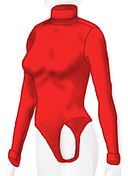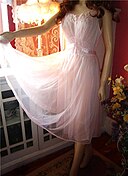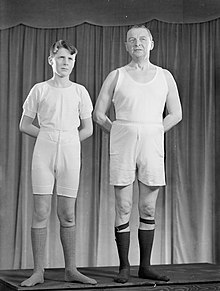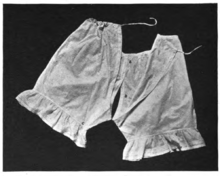underwear
Underwear or undergarment (formerly Lingerie , [ lɛʒ (ə) ri ] or white goods ) referred garments that among other garments ( sub worn scrubbing) directly on the skin and must be washed regularly because of the direct body contact (sub laundering ). The term lingerie is used especially in Switzerland for laundries ( French blanchisserie or buanderie , laundry room).
species
The most common types of underwear are explained in the table below.
| designation | Other names | description | variants |
|---|---|---|---|
| For both sexes | |||
| upper body | |||
T-shirt
|
Sports camisole | A garment that completely covers the upper body and usually has neither buttons nor pockets. Usually with short arms, but there are models with long arms or no arms at all. | |
Undershirt
|
Tank top, underbelly | Similar to a T-shirt, but without arms and with a wide neckline. | |
| Hole body | |||
Long underwear Long-sleeved undershirt and long underpants
 |
Love killer | An often two-piece underwear set that is worn during the cold season. The trousers reach to the ankles. |
|
Bodysuit turtleneck Body with string back, variant of a shirt bodysuits
 |
body | Similar to the leotard, the bodysuit doubles as a shirt and pants. He usually has no or only short legs. Depending on the type and use, the top is also shown publicly as outerwear. It is not uncommon to wear other underwear such as tights, briefs, or bras underneath. However, there is a lock in the crotch to make it easier to go to the toilet. This also enables women to be put on over the head. Variants for men are mostly based on wrestling jerseys and only have a fly or button placket on the front.
Nowadays it is hardly ever worn by men as underwear. |
|
| lower body | |||
Tights Fine tights in 7 denier optics with reinforcement in the form of attractive Rio panties
 |
The tights are abdominal clothing that completely covers the body from the waist down. Depending on the type and use, the leg parts are also shown publicly as outer clothing. It is not uncommon to wear other underwear such as briefs under or over bodysuits, girdles, or jazz pants. Women wear thin, semi-transparent or fully transparent models all year round. Knitted models in all colors are mainly worn by children but also by men during the cold season. |
|
|
Leggings turned to the left side seamless mesh leggings with white cotton gusset
 |
Leggins are tight-fitting pants made of elastic material with usually short legs that are worn as leisure or sportswear. They are often made of synthetic material that can absorb sweat immediately and release it to the outside. Models for cyclists have a wide crotch padding to reduce rubbing against the skin and protect the genitals from the wind. | ||
Slip hip
slip |
Under a slip ( English slip to 'slip) is defined as a relatively scarce, close-fitting underwear or swimsuit which is cut without leg approach. In contrast, the German term `` Schlüpfer '' originally referred to the same parts with a leg attachment. |
|
|
| Worn by women | |||
| upper body | |||
Brassiere
|
bra | Consists of two “cups” for the breasts, which are connected by a band. Another mostly elastic band is tied together on the back or fastened with eyelets. Two straps lead over the shoulders. | |
| lower body | |||
French knickers
|
Wide-cut underpants, mostly made of silk or satin. | ||
| Hole body | |||
Shapewear
|
Shapewear, corsetry | Corsetry is clothing, especially underwear, that is designed to shape the body. Such accessories are available in many different forms, especially for women, and more rarely for men. | |
Slip
|
It served both to maintain body heat and to increase the comfort of a dress. | ||
Neglige
|
Light, playful house or night dress. | ||
Lingerie corsage and thong with lace and satin.
 |
Lingerie | Lingerie is clothing, especially underwear, that is intended to sexually arouse the sexual partner. Such accessories are available in many different forms, especially for women, and more rarely for men. | |
| Worn by men | |||
| upper body | |||
T-shirt , undershirt 
|
Men and women wear T-shirts or undershirts on their upper body. In western cultures it is accepted that men do not wear any outer clothing at all when the weather is nice or when bathing, which women are usually denied (see topless ). | ||
| lower body | |||
Boxer shorts
|
These wide-cut pants are very popular for their comfort. Boxer shorts are also worn instead of pajamas for sleeping . Boxer shorts usually have a fly, which is often buttoned. The legs typically reach halfway down the thigh. | ||
Panties
|
Boxer Briefs | Retro pants and retro shorts are fashionable men's underpants that, in contrast to boxer shorts, are not cut wide, but rather lie close to the skin. | |
Men's briefs
|
Briefs | The traditional men's underpants in Europe, in the past usually with a fly and an elastic waistband. | |
jockstrap
|
Jockstrap | It consists of an elastic waist band, a bag-like bandage to lift the scrotum and two elastic straps that run up to the waist band on the left and right below the buttocks. Athletes prefer to wear jockstraps over ordinary underwear. In the United States, wearing a jockstrap is compulsory in physical education classes in many high schools. As erotic underwear, the jockstrap is also worn directly on the skin. |
|
material
Underwear is usually made from comfortable and skin-friendly materials such as fine rib cotton or silk . In addition, synthetic fibers ( polyamide , polyester ) have been used in the past few decades , especially in the area of lingerie, undergarments / skirts, women's underpants and bras . However, in women's underpants is often a gusset of cotton , of the inserted vaginal opening , but not necessarily the vulva covered. This is rarely the case with men's underpants, but the cotton insert then covers the entire front genital area. As can be seen from history, the purpose of underwear is not necessarily to completely hide sexual characteristics. More recently, synthetically produced materials have increasingly been used as microfibers . These fabrics with up to 8,000 filaments (fibers) per square centimeter (finer than silk) have an extremely low cross-section, are highly elastic, breathable , moisture-repellent and yet dimensionally stable. Underwear or clothing made from knitted or knitted fabrics is also called tricotage .
Fashion


In general, it is considered improper not to wear underwear (especially underpants). Sarah Connor gave rise to major discussions in the press when she appeared on a broadcast of Wetten, dass ..? apparently wearing no panties under her dress.
However, some items of clothing are deliberately designed to be worn without or instead of underwear. These include T-shirts , sportswear like shorts , gym shorts or cycling shorts , running shorts , leotards , bathing suits and some productions of stage costumes. In rare cases, transparent inserts can be incorporated, for example over the entire sides of the torso . Underpants are also often not worn with nightwear such as nightgowns or pajamas . Traditionally, no underwear is worn under a kilt .
history

Images of bikini-like clothing for women are documented from ancient Roman times, but it is not certain whether they were also worn under normal outer clothing. A type of underpants for men has been handed down from the Middle Ages, which looked similar to today's underpants, but here, too, it is not certain whether they were worn in everyday life. Parts of underwear, namely shirts for women and men, have only been reliably documented from the early modern period.
In the 18th century women only wore shirts, stockings and petticoats (or undergarments ) as underwear. Corsets were underwear, but not “underwear” because they could not be washed. Men used to pull their long shirts between their legs at the same time, so that they also took the place of their underpants. From the late 18th century, special men's underpants are documented. Women generally didn't wear panties until the early 19th century. Because of the cumbersome hoop skirts, these were open at the crotch until around 1900. It was only with the reform movement that closed underpants became popular for women.
At the beginning of the 20th century, the types of underwear that we know today develop. Over the course of the century, parts of underwear developed into outerwear (especially the T-shirt, which was originally a men's undershirt) or at least partially became presentable.
Until the 19th century, underwear was made almost exclusively of white linen and called "white goods": linen was relatively cheap and, unlike wool, was easy to wash. Cotton did not become generally affordable until the early 19th century. White was chosen for several reasons:
- Linen must be extensively bleached (by staff, among others) until it is white. Therefore, white fabric is a status symbol.
- White fabric does not stay white for long. Having enough laundry to change before it gets dirty is a status symbol.
- Only undyed fabric could be treated with all chemical (e.g. chlorine solution ) and mechanical (scratching) agents that were necessary to completely remove stains. Dyed fabric would not withstand such treatment.
This preference for white has persisted to this day. That is why (under) linen shops were called "white goods shops" until the 20th century.
literature
- Torkild Hinrichsen (Hrsg.): Bodily - double rib and lace dream. On the cultural history of underwear. Husum Druck- und Verlagsgesellschaft, Husum 2011, ISBN 978-3-89876-571-8 .
- Almut Junker, Eva Stille: The second skin - on the history of underwear 1700–1960. Exhibition by the Historisches Museum Frankfurt, April 28 to August 28, 1988. Historisches Museum, Frankfurt am Main 1988, ISBN 3-89282-010-4 .
- Klaus H. Carl. Parkstone (editor of the German edition): The history of underwear. New York; NY 2010, ISBN 978-1-84484-802-7 .
- Volume 1: Shaun Cole: The History of Men's Underwear.
- Volume 2: Muriel Barbier, Shazia Boucher: The History of Lingerie.
- Christel Dietz: Study on the influence of different underwear on the dry heat release of the skin under room temperature conditions Leipzig, 1969 (Dissertation University of Leipzig, Medical Faculty, September 22, 1969, 138 pages).
Web links
Individual evidence
- ↑ Connors 'Wetten, dass ...' Scandal: 'I didn't mean to provoke' . spiegel.de. January 28, 2002. Retrieved May 26, 2016.





